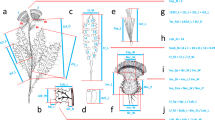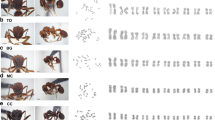Abstract
The acridine grasshopper, Caledia captiva exists as two chromosomal races in south-east Queensland. One of these, the “Moreton” race inhabits the coastal region to the east of the Great Dividing Range. All chromosomes of the complement (2n=11II+XO/XX) have been involved in centromeric rearrangement, which transforms the acro- and telocentric chromosomes into submeta- and metacentric elements. The second, or “Torresian” race is widely distributed through southern Papua, Arnhem Land, Cape York Peninsula and down the east coast of Australia as far south as Brisbane. This race, which is characterised by a completely acro- and telocentric chromosome complement, approaches the “Moreton” race in south-east Queensland where the two races are separated by less than 1 km, along a front of at least 150 km. Evidence is presented to show that chromosome introgression is occurring across the contact zone and this takes place in one direction only, namely the “Torresian” chromosomes are infiltrating into the “Moreton” race but not reciprocally. Furthermore, the introgression of chromosomes across the zone is limited to certain members of the Torresian complement and even then these successful chromosomes show highly variable degrees of penetrance into the “Moreton” race. It is proposed that a “tension zone” exists between these two races which is maintained by the interaction of (a) ecological tolerance differences on either side of the zone and (b) by partial competitive exclusion due to the interracial differences in phenology. This case of parapatric association with limited hybridisation is unique in its clarity due to the marked differences in the appearance of the chromosome complements of these races which permits direct assessment of the behaviour of most members of the genome in hybrids and their derivatives.
Similar content being viewed by others
References
Baker, R.J., Bleier, W.J., Atchley, W.R.: A contact zone between karyotypically characterized taxa of Uroderma bilobatum (Mammalia: Chiroptera). Syst. Zool. 24, 133–142 (1976)
Burbidge, N.T.: The phytogeography of the Australian region. Aust. J. Bot. 8, 75–212 (1960)
Craddock, E.M.: Intraspecific karyotypic differentiation in the Australian Phasmatid Didymuria violescens (Leach) 1. The chromosomal races and their structural and evolutionary relationships. Chromosoma (Berl.) 53, 1–24 (1975)
Fitzpatrick, E.A., Nix, H.A.: The climatic factor in Australian grassland ecology. In: Australian grasslands (R. Milton Moore ed.), pp. 3–26. Canberra: Australian National University Press 1973
Greenbaum, I.F., Baker, R.J.: Evolutionary relationships in Macrotus (Mammalia: Chiroptera): Biochemical variation and cytology. Syst. Zool. 25, 15–25 (1976)
Hall, W.P.. Selander, R.K.: Hybridisation of karyotypically differentiated populations in the Sceloporus grammicus complex (Iguanidae). Evolution (Lawrence, Kans.) 27, 226–242 (1973)
Hewitt, G.M.: A sex chromosome hybrid zone in the grass hopper Podisma pedestris (Orthoptera: Acrididae). Heredity 35, 375–387 (1975)
Ingram, G.J., Corben, C.J.: The frog fauna of North Stradbroke Island, with comments on the “acid” frogs of the wallum. Proc. roy. Soc. Qd. 86, 49–54 (1975)
Keast, A.: Bird speciation on the Australian continent. Bull. Mus. comp. Zool. Harv. 123, 305–495 (1961)
Keast, A.: Vertebrate speciation in Australia; some comparisons between birds, marsupials and reptiles. In: The evolution of living organisms (G.W. Leeper, ed.), pp. 380–407. Melbourne: Melbourne University Press 1962
Key, K.H.L.: The concept of stasipatric speciation. Syst. Zool. 17, 14–22 (1968)
Key, K.H.L.: Speciation in the Australian Morabine grasshoppers — taxonomy and ecology. In: Genetic mechansims of speciation in insects (M.J.D. White, ed.), pp. 43–56. Sydney: Australia and New Zealand Book Co. 1974
Kershaw, A.P.: A long continuous pollen sequence form northeastern Australia. Nature (Lond.) 251, 222–223 (1974)
Mayr, E.: Animal species and evolution. Cambridge, Mass.: Harvard University Press 1963
Mrongovius, M.: Studies of hybrids between members of “viatica” group of Morabine grasshoppers. Ph. D. thesis. University of Melbourne 1975
Nadler, C.F., Hoffmann, R.S., Greer, K.R.: Chromosomal divergence during evolution of ground squirrel populations (Rodentia: Spermophilus). Syst. Zool. 20, 298–305 (1971)
Nix, H.A., Kalma, J.D.: Climate as a dominant control in the biogeography of northern Australia and New Guinea. In: Bridge and barrier: The natural and cultural history of Torres Strait (D. Walker, ed.). Research School of Pacific Stud. Publ. B9/3, pp. 61–91. Canberra: Australian National University 1972
Patton, J.L.: Chromosome evolution in the pocket mouse, Perognathus goldmani Osgood. Evolution (Lawrence, Kans.) 23, 645–662 (1969)
Schmidly, D.J., Schroeter, G.L.: Karyotypic variation in Peromyscus boylii (Rodentia: Cricetidae) from Mexico and corresponding taxonomic implications. Syst. Zool. 23, 333–342 (1974)
Shaw, D.D.: Population cytogenetics of the genus Caledia (Orthoptera: Acridinae) 1. Inter and intraspecific karyotype diversity. Chromosoma (Berl.) 54, 221–243 (1976)
Shaw, D.D., Webb, G.C., Wilkinson, P.: Population cytogenetics of the genus Caledia (Orthoptera: Acridinae) 11. Variation in the pattern of C-banding. Chromosoma (Berl.) 56, 169–190 (1976)
Straughn, I.R., Main, A.R.: Speciation and polymorphism in the genus Crinia Tschudi (Anura: Leptodactylidae) in Queensland. Proc. roy. Soc. Qd. 78, 11–28 (1966)
Thaeler Jr., C.S.: Karyotypes of sixteen populations of the Thomomys talpoides complex of Pocket Gophers (Rodentia: Geomyidae). Chromosoma (Berl.) 25, 172–183 (1968)
Wahrman, J., Goitein, R., Nevo, E.: Mole Rat Spalax: Evolutionary significance of chromosome variation. Science 164, 82–84 (1969)
White, M.J.D.: Speciation in the Australian Morabine grasshoppers — the cytogenetic evidence. In: Genetic mechanisms of speciation in insects (M.J.D. White, ed.), pp. 57–68. Sydney: Australia and New Zealand Book Co. 1974
White, M.J.D.: Chromosomal repatterning — regularities and restrictions. Genetics 79, 63–72 (1975)
Author information
Authors and Affiliations
Rights and permissions
About this article
Cite this article
Moran, C., Shaw, D.D. Population cytogenetics of the genus Caledia (Orthoptera: Acridinae). Chromosoma 63, 181–204 (1977). https://doi.org/10.1007/BF00292729
Received:
Accepted:
Issue Date:
DOI: https://doi.org/10.1007/BF00292729




